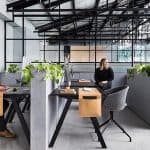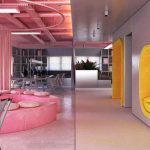Unpacking the design process: Why it all starts with a solid design concept
Two of our top designers Lauren and Nicky sat down to discuss the process behind what we do here at Outline Design, their top commercial design tips, and why the key to any beautiful project starts with a solid design concept. Happy reading!
“What inspired you to get into commercial interior design?“
L: “I’ve wanted to be an interior designer since I was eight so it’s something I’ve always loved. I’d say when I was younger I thought I’d go into residential, but I realised I quite liked the puzzle of commercial design and especially workplace design. It’s all about fitting things in and figuring out how to make a layout work efficiently yet comfortably. And then you have the element of technology that is added into how you design a commercial space which is another reason why I love it.”
N: “I also never knew what aspect of interior design I wanted to pursue, at one point I wanted to cross over to architecture right out of university. But, once I started actually working on commercial interior projects, I realised that’s what I loved and carried on in that sector.”

“How do you draw the distinction between what an architect does and what an interior designer does?“
L: “I always like to describe architects as focusing more on the envelope of a project while designers focus more on the letter. If you work with a great architect and team, together you create spaces that change the way people move through and experience those areas. But I’d say designers consider more how people move through a particular space whereas architects focus more on how people move through a building. For example, we might look at how to get power to a collaboration hub, whereas architects might consider things such as where to place fire exits. So we sort of layer together but generally they do the envelope and we do the letter.”
“When you receive a brief, how do you start the concept creation process?“
L: “Well I think you are always led by the client first. It is really important to understand exactly what they want the space to achieve and how they want people to interact within it. We have to consider functionality, the culture within the company, and then often it also comes down to budget. So we generally start with all those parameters in our head first and then that lays the foundation for our seed idea and concept.”

“Why is a solid concept so important for your projects?“
L: “I always think of a concept as the skeleton of a design. It provides the bones and then you are able to pack it out from there, with everything else relating back to that initial concept and creating a consistent feel throughout. As a designer you can never say ‘oh we picked that because we like it’, you always to have a justification and that’s where good planning and theory comes in. A solid concept also makes it easier to present your ideas to clients because you have a clear vision and explanation as to why they should implement the design choices. And again, it often comes back to costs. It’s quite a skill to deliver a really quality design using a limited budget, so a good concept helps to ensure you stay within the tight constraints while delivering beautiful spaces at the same time.”
“What are key elements that contribute to a design concept?“
N: “It’s always client specific, but I think branding and the values of the company are key. I also think future proofing is really important to have in mind whenever you start a concept to ensure they can adapt the space to meet evolving needs. Therefore, establishing where the client sees themselves as a business in say 5 to 10 years is critical.”
L: “I have always found it hard to design in complete isolation. I always design in a 3 dimensional way so you may start with a layout design but often you are already thinking about the furniture and the colours coming into the space. At the end of the day layout will always be one of the most important elements as it tells you want you can fit in the space, but I think for commercial companies, branding is also super important. Then I guess the furnishings and colours and so on are layered on top of layout, branding and overall feel. Then finally I’d say the textures, fixtures and smaller details will sort of come in last.”
“What is your favourite part of the design process?“
L: “The concept planning for sure. I mean it’s always awesome to see it come together at the end but the concept plan is my favourite.”
N: “Ooh that’s hard. I love every part of it, but I do really enjoy the space planning and puzzling through how to make an area work. And I also love doing the technical drawings and getting into the finer details.”

“If you could pick 3 top design tips for someone who wants to recreate their own commercial space, what advice would you give them?“
L: “One, know your budget. Two, know what you love, even if you don’t have a clear idea but you have a group of things you like and can draw a theme from that. And then three, have realistic expectations of a timeline. Achieving your design goals are often determined by clearly understanding those three things; taste, timeline, and budget.”
N: “I would say talk to your team and ensure you really understand what works for the people who are going to be using the space, because often the person in charge of organising the project might not be the one actually using it. I would also say furniture is key, so make sure you are only including things in the space that will be used and used well, and you can’t do that without a clear vision of the space’s purpose. Understanding your company culture is also really important, and just because something works well for one area doesn’t mean it will work for another. So taking the time to understand what you want the space to say about your brand, the people who work there, and the experience you want them to have when engaging in that area is key.”
About Outline Design
Outline Design is an established commercial interior design firm based in Auckland, New Zealand offering the full range of interior design services. To find out more contact us.







